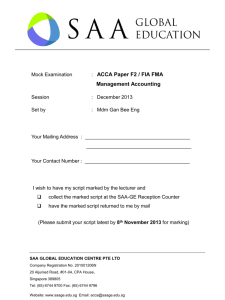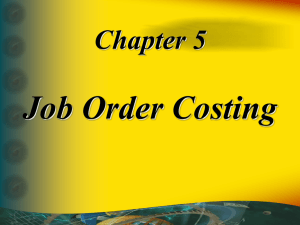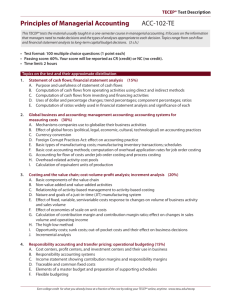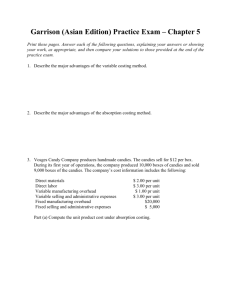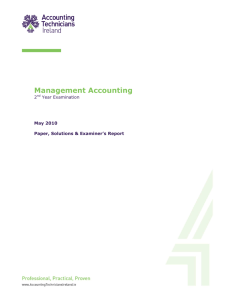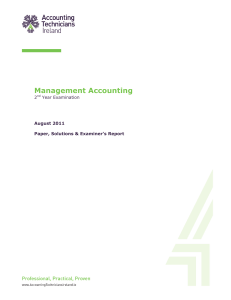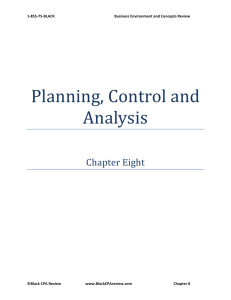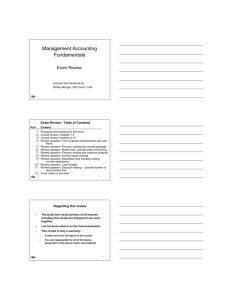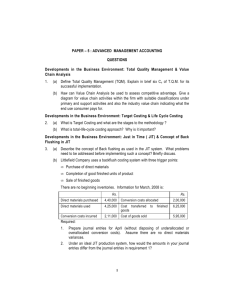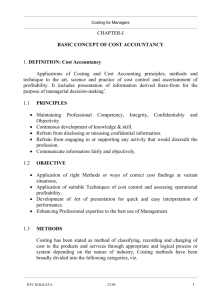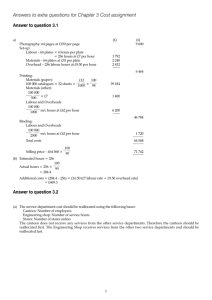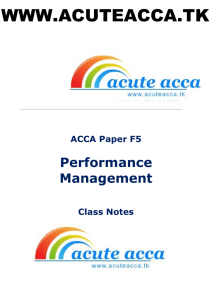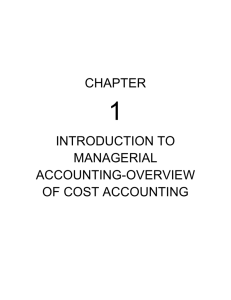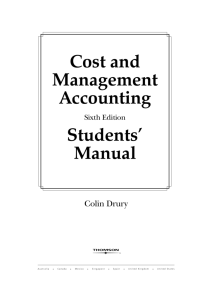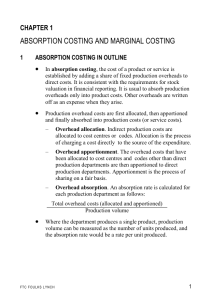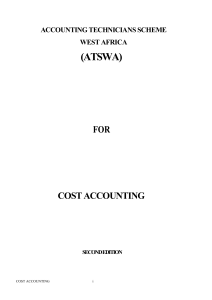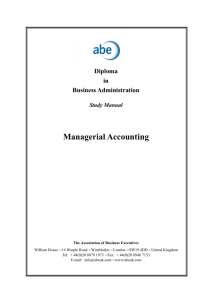Q.2 (a) The unit product cost under variable costing can be
advertisement
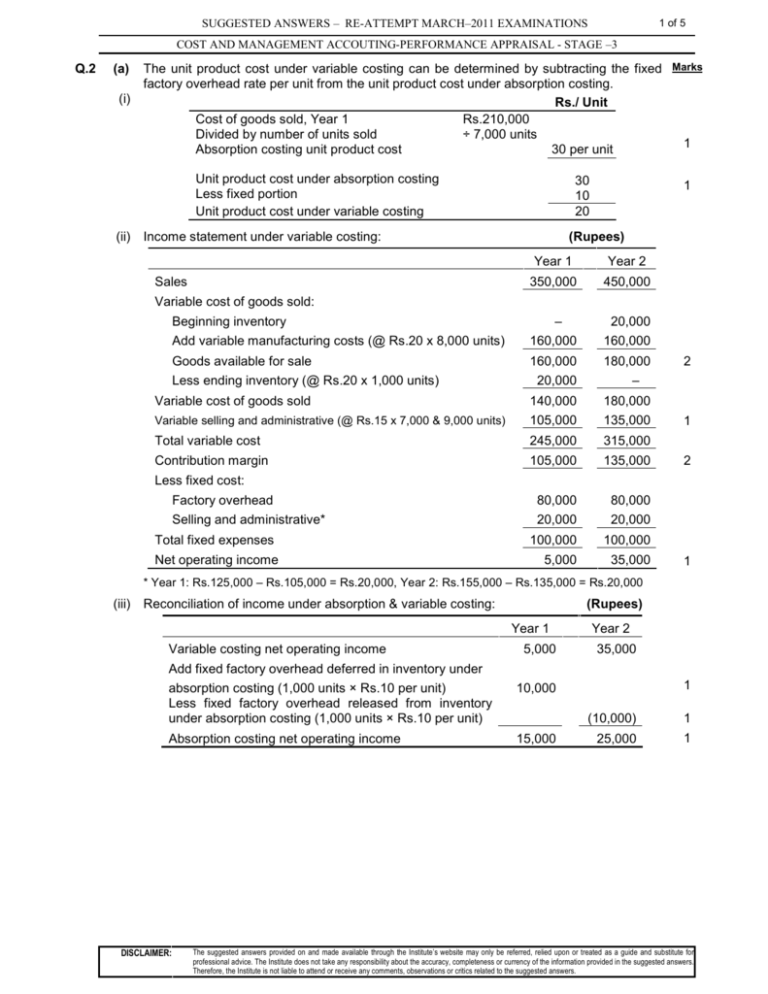
1 of 5 SUGGESTED ANSWERS – RE-ATTEMPT MARCH–2011 EXAMINATIONS COST AND MANAGEMENT ACCOUTING-PERFORMANCE APPRAISAL - STAGE –3 Q.2 (a) (i) The unit product cost under variable costing can be determined by subtracting the fixed Marks factory overhead rate per unit from the unit product cost under absorption costing. Rs./ Unit Cost of goods sold, Year 1 Rs.210,000 Divided by number of units sold ÷ 7,000 units 1 Absorption costing unit product cost 30 per unit Unit product cost under absorption costing Less fixed portion Unit product cost under variable costing (ii) 30 10 20 Income statement under variable costing: Sales 1 (Rupees) Year 1 Year 2 350,000 450,000 Variable cost of goods sold: Beginning inventory – 20,000 Add variable manufacturing costs (@ Rs.20 x 8,000 units) 160,000 160,000 Goods available for sale 160,000 180,000 Less ending inventory (@ Rs.20 x 1,000 units) 20,000 2 – Variable cost of goods sold 140,000 180,000 Variable selling and administrative (@ Rs.15 x 7,000 & 9,000 units) 105,000 135,000 Total variable cost 245,000 315,000 Contribution margin 105,000 135,000 Factory overhead 80,000 80,000 Selling and administrative* 20,000 20,000 100,000 100,000 5,000 35,000 1 2 Less fixed cost: Total fixed expenses Net operating income 1 * Year 1: Rs.125,000 – Rs.105,000 = Rs.20,000, Year 2: Rs.155,000 – Rs.135,000 = Rs.20,000 (iii) Reconciliation of income under absorption & variable costing: (Rupees) Year 1 Variable costing net operating income 5,000 Year 2 35,000 Add fixed factory overhead deferred in inventory under absorption costing (1,000 units × Rs.10 per unit) Less fixed factory overhead released from inventory under absorption costing (1,000 units × Rs.10 per unit) 10,000 Absorption costing net operating income 15,000 DISCLAIMER: 1 (10,000) 1 25,000 1 The suggested answers provided on and made available through the Institute’s website may only be referred, relied upon or treated as a guide and substitute for professional advice. The Institute does not take any responsibility about the accuracy, completeness or currency of the information provided in the suggested answers. Therefore, the Institute is not liable to attend or receive any comments, observations or critics related to the suggested answers. 2 of 5 SUGGESTED ANSWERS – RE-ATTEMPT MARCH–2011 EXAMINATIONS COST AND MANAGEMENT ACCOUTING-PERFORMANCE APPRAISAL - STAGE –3 (b) Marks Cost of Production Report – Weighted Average Method Quantity schedule and equivalent units Units to be accounted for: Work in process, beginning Started into production Total units accounted for Equivalent Units Units accounted for as follows: Transferred to next department Work in process, ending Total units Costs per equivalent unit (Rs.) Cost to be accounted for: Work in process, beginning Cost added during the month Total cost (a) Equivalent units (above) (b) Cost per equivalent unit, (a) ÷ (b) Cost per whole unit Cost reconciliation (Rs.) Cost accounted for as follows: Transferred out Work in process, ending: Materials Conversion Total work in process, ending Total cost Q.3 (a) (i) 800 16,000 16,800 Total 2 Materials Conversion 16,500 300 16,800 16,500 180 16,680 16,500 210 16,710 Total Cost Materials Conversion 3,712 544,289 548,001 1,296 47,076 48,372 2,416 497,213 499,629 16,680 2.900 16,710 29.900 32.800 Total Cost 541,200 16,500 522 6,279 6,801 548,001 180 (ii) b. Materials quantity variance = SP(AQ – SQ*) = Rs.38.00(4,700 – 4,692) = Rs.304 U *SQ = Standard quantity per unit × Actual output = 2.3 × 2,040 = 4,692 2 1 16,500 1 210 1 1 1 Marks 2 2 1 (iii) Journal entries to record the purchase and use of the raw material: Record the purchase of the raw material: Raw Materials 193,800 Materials price variance 7,650 Accounts payable 201,450 DISCLAIMER: 2 Equivalent Units Materials Conversion Materials price variance = (AQ × AP) – (AQ × SP) = Rs.201,450 – (5,100 × Rs.38.00) = Rs.7,650 U Record the use of the raw material: Work in process Materials quantity variance Raw materials 2 178,296 304 178,600 1 1 1 1 1 1 The suggested answers provided on and made available through the Institute’s website may only be referred, relied upon or treated as a guide and substitute for professional advice. The Institute does not take any responsibility about the accuracy, completeness or currency of the information provided in the suggested answers. Therefore, the Institute is not liable to attend or receive any comments, observations or critics related to the suggested answers. 3 of 5 SUGGESTED ANSWERS – RE-ATTEMPT MARCH–2011 EXAMINATIONS COST AND MANAGEMENT ACCOUTING-PERFORMANCE APPRAISAL - STAGE –3 Marks (b) (i) Labour rate variance = (AH × AR) – (AH × SR) = Rs.205,100 – (2,800 × Rs.70) = Rs.9,100 U 2 (ii) Labour efficiency variance = SR(AH – SH*) = Rs.70 (2,800 – 3,360) 2 = Rs.39,200 F *SH = Standard hours per unit × Actual output = 8.4 × 400 = 3,360 1 (iii) Journal entries to record the direct labour costs: Work in process Labour rate variance Labour efficiency variance Wages payable (or cash) Q.4 (a) (i) 235,200 9,100 1 1 1 1 39,200 205,100 Variable overhead spending variance = (AH × AR) – (AH × SR) = Rs.110,670 – (6,200 × Rs.17.55) = Rs.1,860 U 2 (ii) SH = Standard hours per unit × Actual output = 0.6 × 10,200 = 6,120 1 Variable overhead efficiency variance = SR(AH – SH) = Rs.17.55(6,200 – 6,120) = Rs.1,404 U (b) 2 (Rupees) Cost formula per unit of activity Variable costs: Supplies Power Total variable cost Fixed costs: Administration Depreciation Total fixed cost Total cost DISCLAIMER: 44.60 17.20 61.80 Actual costs incurred Budget based on actual activity Variance 4,050 1,690 5,740 4,460 1,720 6,180 410 30 440 F F F 2 2 6,240 6,280 12,520 18,260 6,200 6,200 12,400 18,580 40 80 120 320 U U U F 2 2 1 The suggested answers provided on and made available through the Institute’s website may only be referred, relied upon or treated as a guide and substitute for professional advice. The Institute does not take any responsibility about the accuracy, completeness or currency of the information provided in the suggested answers. Therefore, the Institute is not liable to attend or receive any comments, observations or critics related to the suggested answers. 4 of 5 SUGGESTED ANSWERS – RE-ATTEMPT MARCH–2011 EXAMINATIONS COST AND MANAGEMENT ACCOUTING-PERFORMANCE APPRAISAL - STAGE –3 Q. 5 Capacity Level Direct Labour Hourse Variable overhead Supplies Indirect labour (Excluding. Insp) Bonus & other benefits Heat, light & power Inspection Others Total variable overhead Variable OH rate per D.L.HR Annual fixed overehad Salaries, allowance & benefits Maintenance cost Insurance & taxes Depreciation Heat, light & power Inspection Others Total annual fixed overhead Fixed OH rate per D.L.HR Total factory overhead Total factory overhead per D.L.HR 80% 40,000 Rs. 90% 45,000 Rs. 400,000 1,800,000 6,360,000 120,000 480,000 560,000 9,720,000 2 + 243 450,000 2,025,000 7,155,000 135,000 540,000 630,000 10,935,000 2 + 243 500,000 2,250,000 7,950,000 150,000 600,000 700,000 12,150,000 2 243 3,600,000 2,400,000 300,000 900,000 20,000 420,000 190,000 7,830,000 2 + 196 3,600,000 2,400,000 300,000 900,000 20,000 420,000 190,000 7,830,000 2 + 174 3,600,000 2,400,000 300,000 900,000 20,000 420,000 190,000 7,830,000 2 157 17,550,000 439 18,765,000 417 Working Notes: Marks 100% 50,000 Rs. 19,980,000 400 Presentation . 6 1 . 6 1 1 1 (Rupees) Bonus & other benefits Direct labour (50,000 hrs x Rs.750) Indirect labour (50,000 hrs x Rs.45) Total labour cost 37,500,000 2,250,000 39,750,000 7,950,000 20% 1 Heat, light & power High Low Hours 50,000 40,000 10,000 Variable cost per D.L. HR.(30,000/ 10,000) Total cost Variable cost (50000 x 3) Fixed cost Inspection High Low Cost Rs. 170,000 140,000 30,000 3 170,000 150,000 20,000 50,000 40,000 10,000 Variable cost per D.L. HR.(120,000/ 10,000) 1,020,000 900,000 120,000 12 Total cost Variable cost (50000 x 12) Fixed cost 1,020,000 600,000 420,000 1 1 Others High Low DISCLAIMER: 50,000 40,000 10,000 Variable cost per D.L. HR.(140,000/ 10,000) 890,000 750,000 140,000 14 Total cost Variable cost (50000 x 12) Fixed cost 890,000 700,000 190,000 1 The suggested answers provided on and made available through the Institute’s website may only be referred, relied upon or treated as a guide and substitute for professional advice. The Institute does not take any responsibility about the accuracy, completeness or currency of the information provided in the suggested answers. Therefore, the Institute is not liable to attend or receive any comments, observations or critics related to the suggested answers. SUGGESTED ANSWERS – RE-ATTEMPT MARCH–2011 EXAMINATIONS 5 of 5 COST AND MANAGEMENT ACCOUTING-PERFORMANCE APPRAISAL - STAGE –3 Q.6 Marks (a) (i) Margin = Net operating income ÷ Sales = Rs.609,840 ÷ Rs.10,890,000 = 5.6%. 1 (ii) Turnover = Sales ÷ Average operating assets = Rs.10,890,000 ÷ Rs.3,000,000 = 3.6 1 (iii) ROI = Net operating income ÷ Average operating assets = Rs.609,840 ÷ Rs.3,000,000 = 20.3% 1 (iv) Residual income = Net operating income - Minimum required rate of return × Average operating assets = Rs.609,840 – (16% × Rs.3,000,000) = Rs.129,840 2 (b) From the perspective of Division B, profits would increase as a result of the transfer if and only if: Transfer price ≥ Variable cost + Opportunity cost 1 The opportunity cost is the contribution margin on the lost sales, divided by the number of units transferred: Opportunity cost = [(Rs.18.00 - Rs.9.00 - Rs.1.00) × 3,000*]/6,000 = Rs.4.00 2 * Demand from outside customers Units required by Division B Total requirements Capacity Required reduction in sales to outside customers 27,000 6,000 33,000 30,000 3,000 1 Therefore, Transfer price ≥ Rs.9.00 + Rs.4.00 = Rs.13.00. 1 From the viewpoint of Division A, the transfer price must be less than the cost of buying the units from the outside supplier. Therefore, Transfer price ≤ Rs.17.00. 1 Combining the two requirements, we get the following range of transfer prices: Rs.13.00 ≥ Transfer price ≤ Rs.17.00. 1 THE END DISCLAIMER: The suggested answers provided on and made available through the Institute’s website may only be referred, relied upon or treated as a guide and substitute for professional advice. The Institute does not take any responsibility about the accuracy, completeness or currency of the information provided in the suggested answers. Therefore, the Institute is not liable to attend or receive any comments, observations or critics related to the suggested answers.
